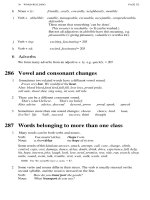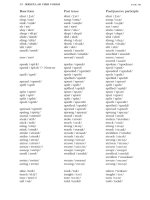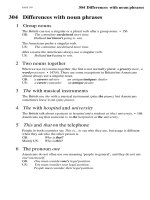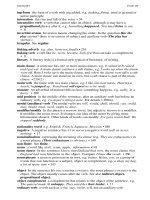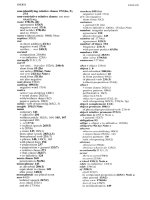Tài liệu Betty Azar - Basic English Grammar 2e-chapter1 pptx
Bạn đang xem bản rút gọn của tài liệu. Xem và tải ngay bản đầy đủ của tài liệu tại đây (13.97 MB, 54 trang )
BASIC
ENGLISH
GRAMMAR
Please purchase PDF Split-Merge on www.verypdf.com to remove this watermark.
ENGLISH
GRAMMAR
Second Edition
Please purchase PDF Split-Merge on www.verypdf.com to remove this watermark.
Librsry
of Congrcecl
Cataloging-ln-Public
Data
Azar, Betty Scrampfer, 1941-
Basic English grammar
I
Betty Schrampfer Azar.
2nd ed.
D.
cm.
1ncludes indexes.
ISBN 0-13-368317-6
ISBN 0-13-368424-5 (v. 1). ISBN 0-13-368358-3
(v.
2)
1. English language Textbooks for foreign speakers. 2. English
language Grammar Problems, exercises, etc. I. Title.
PE1128.A96 1995
428.2'4 dc20 92-2571 1
CIP
Publisher:
Tina
B.
Carver
Director of Production and Manufacnuing:
Aliza
Gremblan
Editorial Production/Design Manager:
Domini& Mosco
Editorial/Production Supervision:
Janet Johnston
Editorial Assistant:
ShUey
Hartle
Production Coordinator:
Ray Keating
Cover Coordinator:
Merle Krumper
Cover Production:
Molly
Piks
Riccardi
Cover Design:
Joel Mirnick Design
Interior Design:
Ros Hmon F~eese
Illustrations:
Don Martinetti
01996 by Betty Schrampfer Azar
A
Psarson Education Company
pearson
Bducation
10
Bank
Stren
White
Plains,
NY
10606
All rights re9e~e.d. No part of this book may be
reproduced,
in
any form or by any means,
without permission in writing
from
the publisher.
Printed in the United States of America
15
ISBN 0-33-3b8337-b
ISBN 0-33-3b8b29-5
(Val.
A)
ISBN 0-33-3b8358-3
(Val.
0)
Please purchase PDF Split-Merge on www.verypdf.com to remove this watermark.
Contents
PREFACE TO THE SECOND EDITION
ix
ACKNOWLEDGMENTS
x
51
f
.
Chapter
1
USING BEAND HAVE
.
.
:
U
fl
-
NOUN
+
IS
+
NOUN: SINGULAR
2
NOUN
+ARE
+
NOUN: PLURAL
4
PRONOUN
+
BE
+
NOUN
6
CONTRACTIONS
WITH
BE
7
NEGATIVE WITH
BE
8
BE
+
ADJECTIVE
10
BE
+
A LOCATION
16
SUMMARY: SENTENCE PATTERNS WITH
BE
20
YESNO QUESTIONS WITH
BE
21
QUESTIONS WITH
BE:
USING
WHERE
24
USING
HAVE
AND
HAS
26
USING
MY, YOUR, HIS, HER, OUR, THEIR
27
USING
THIS
AND
THAT
30
USING
THESE AND THOSE
31
ASKING QUESTIONS WITH WHATAND
WHO +BE
32
.I?'
Chapter
2
EXPRESSING PRESENT TIME (PART
I)
'17'1
.
L
FORM AND BASIC MEANING OF THE SIMPLE PRESENT TENSE
44
USING FREQUENCY ADVERBS:
ALWAYS. USUALLY. OFTEN.
SOMETIMES. SEL.DOM. R.4REL.Y. NEW
46
USING FREQUENCY ADVERBS WITH
BE
47
PRONUNCIATION OF FINAL
-S:
/Z/
AND
/S/
49
SPELLING AND PRONUNCIATION OF FINAL
-ES
51
ADDING FINAL
-S/-ES
TO WORDS THAT END
IN
-Y
1
IRREGULAR SINGULAR VERBS:
HAS, DOES, GOES
52
SUMMARY: SPELLING
AND
PRONUNCIATION OF
-SAND -ES
54
THE SIMPLE PRESENT
.
NEGATIVE
57
CONTENTS
.
//I
Please purchase PDF Split-Merge on www.verypdf.com to remove this watermark.
2-10
THE
SIMPLE PRESENT: YESNO QUESTIONS
6
I
2-1
1
THE SIMPLE PRESENT: ASKING INFORMATION QUESTIONS
WITH
WHERE
64
2-12
THE
SIMPLE PRESENT: ASKING INFORMATION QUESTIONS
WITH
WHEN
AND
WHAT TIME
66
2-13
SUMMARY: INFORMATION QUESTIONS
WITH
BE
AND
DO
67
2-14
USING lTTO TALK ABOUT
TIME
72
2-1 5
PREPOSITIONS OF TIME
73
2-16
USING ITTO TALK ABOUT
THE
WEATHER
74
Chapter
3
EXPRESSING PRESENT TIME (PART
2)
"
. .
BE
+
JNG:
THE PRESENT PROGRESSIVE TENSE
84
SPELLING OF
-ZNG
87
THE PRESENT PROGRESSIVE
.
QUESTIONS
89
THE SIMPLE PRESENT vs
.
THE PRESENT PROGRESSIVE
92
NONACTION VERBS NOT USED
IN
THE PRESENT PROGRESSIVE
95
SEE, LOOKAT, WATCH, HEAR,
AND
LISTEN
TO
97
NEED
AND
WANT
+
A NOUN OR AN
98
WOULD LIKE
100
.
WOULDLIKEvs
LJKE
101
THINK ABOUT
AND
THINK
THAT
102
THERE
+
BE
106
THERE
+
BE
YESNO QUESTIONS
i
107
THERE
+
BE
ASKING QUESTIONS
WITH
HOWMANY
109
PREPOSITIONS OF LOCATION
11
Chapter
4
NOUNS AND PRONOUNS
NOUNS: SUBJECTS
AND
OBJECTS
127
ADJECTIVE
+
NOUN
129
SUBJECT PRONOUNS AND OBJECT PRONOUNS
131
NOUNS: SINGULAR AND PLURAL
134
NOUNS: IRREGULAR PLURAL FORMS
139
NOUNS: COUNT AND NONCOUNT
141
.
USINGANvs
A
143
.
USING
A/AN vs SOME
144
MEASUREMENTS
WITH
NONCOUNT NOUNS
150
USING
THE
156
USING
0
(NO ARTICLE) TO
MAKE
GENERALIZATIONS
160
USING
SOME
AND
ANY
161
INDEFINITE PRONOUNS:
SOMETHING, SOMEONE,
ANYTHING, ANYONE
163
INDEFINITE PRONOUNS:
NOTHING
AND
NO ONE
164
Please purchase PDF Split-Merge on www.verypdf.com to remove this watermark.
Chapter
5
EXPRESSING PAST TIME
v
.
Chapter
6
USING
BE:
PAST
TIME
171
PAST OF
BE:
NEGATIVE
172
PAST OF
BE:
QUESTIONS
173
THE SIMPLE PAST TENSE: USING
-ED
177
PAST TIME WORDS:
YESTERDAY, LAST,
AND
AGO
178
PRONUNCIATION OF
-ED: It/,
Id/,
AND
ladl
180
SPELLING OF
-ED
VERBS
183
SPELLING OF
-ED
AND
-ING:
TWO-SYLLABLE VERBS
186
THE
SIMPLE PAST: IRREGULAR VERBS
190
THE
SIMPLE PAST: NEGATIVE
192
THE SIMPLE PAST: YES/NO QUESTIONS
9
MORE IRREGULAR VERBS
198
THE SIMPLE PAST: USING
WHERE, WHEN, WHAT TIME,
AND
WHY
203
QUESTIONS WITH
WHAT
206
QUESTIONS WITH
WHO
209
ASKING ABOUT THE MEANING OF A WORD
212
MORE IRREGULAR VERBS
213
BEFORE
AND
AFTER
IN TIME CLAUSES
216
WHEN
IN
TIME
CLAUSES
219
. .
-8
EXPRESSING
FUTURE
TlME
FUTURE
TIME: USING
BE GOING TO
:
:.L
L
231
WORDS USED FOR PAST
TIME
AND
FUTURE
TIME
235
USING
A COUPLE OF
OR
A FEW
WITH
AGO
(PAST)
AND
LV
(EUTURE)
238
USING
TODAY, TONIGHT,
AND
THIS
+
MORNING,
AFTERNOON, EVENING,
WEEK,
MONTH, YEAR
239
FUTURE
TIME: USING
WILL
242
ASKING QUESTIONS WITH
WIU
243
VERB SUMMARY: PRESENT, PAST,
AND
FUTURE
245
VERB SUMMARY: FORMS OF
BE
246
USING
WHAT
+
A FORM OF
DO
251
MAYIMIGHTvs
.
WILL
253
MAYBE
(ONE WORD)
vs
.
MAYBE
(TWO WORDS)
255
FUTURE
TIME CLAUSES WITH
BEFORE, AFTER,
AND
WHEN
258
CLAUSES WITH
IF
260
EXPRESSING HABITUAL PRESENT WITH TIME CLAUSES
AND
IF-CLAUSES
263
MORE IRREGULAR VERBS
266
MORE IRREGULAR VERBS
270
CONTENTS
V
Please purchase PDF Split-Merge on www.verypdf.com to remove this watermark.
Chapter
7
EXPRESSING ABILITY
USING CAN
281
USING CAN: QUESTIONS
282
USING KNOWHOW TO
284
USING COULD: PAST OF CAN
285
USING VERY
AND
TOO
+
ADJECTIVE
287
USING TOO
MANY
AND
TOO MUCH
+
NOUN
290
USING TOO
+
ADJECTIVE
+
INKNITIW
293
USING TOO
+
ADJECTIVE
+
FOR (SOMEONE)
+
INFINITIVE
294
USING ADJECTIVE
+
ENOUGH
295
USING ENOUGH
+
NOUN AND MORE
+
NOUN
297
USING ENOUGH
+
INFINITIVE
299
USING BERBLB TO
301
POLITE QUESTIONS: MAYI. COULD I.
AND
CANI
302
POLITE QUESTIONS: COULD YOU
AND
WOULD YOU
,304
IMPERATIVE SENTENCES
307
USING TWO. TOO.
AND
TO
310
MORE ABOUT PREPOSITIONS: AT
AND
IN
FOR LOCATIONS
311
MORE IRREGULAR VERBS
321
Chapter
8
NOUNS
.
ADJECTIVES AND PRONOUNS
.
.
>
.,
I-
1
MODIFYING NOUNS
WITH
ADJECTIVES
AND
NOUNS
325
WORD ORDER OF ADJECTIVES
329
EXPRESSIONS OF QUANTITY:
ALL
OF. MOST OF. SOME OF
334
EXPRESSIONS OF QUANTITY: SUBJECT-VERB AGREEMENT
336
EXPRESSIONS OF QUANTJ3Y ONE OF. NONE OF
337
USING EVERY
341
POSSESSIVE NOUNS
343
POSSESSIVE: IRREGULAR PLURAL NOUNS
345
POSSESSIVE PRONOUNS:
MINE,
YOURS. HIS.
HERS,
OURS, THEIRS
347
QUESTIONS
WITH
WHOS6
351
SUMMARY: USES OF
THE
APOSTROPHE
352
SUMMARY: USES OF NOUNS
355
CONNECTED NOUNS: NOUN +AND/OR
+
NOUN
357
SUMMARY: USES OF ADJECTIVES
360
SUMMARY PERSONAL PRONOUNS
363
INDIRECT OBJECTS
364
INDIRECT OBJECTS: USING FOR
367
INDIRECT OBJECTS
Wm
BUY,
GET,
MAKE
369
INDIRECT OBJECTS
WITH
EXFLAlN
AND
INTRODUCE
370
MORE IRREGULAR VERBS
375
Please purchase PDF Split-Merge on www.verypdf.com to remove this watermark.
Chapter
9
MAKING COMPARISONS
COMPARISONS: USING
THE SAME (AS). SIMILAR
(TO).
AND
DIFFERENT (PROM)
379
COMPARISONS: USING
LIKE AND ALIKE
382
THE COMPARATIVE: USING
-ER AND MORE
383
USING
AS
AS;
USING
LESS
389
USING
BUT
393
USING VERBS AFTER
BUT
395
THE
SUPERLATNE: USING
-ESTAND MOST
398
USING
ONE OF
+
SUPERLATIVE
+
PLURAL NOUN
405
ADJECTIVES
AND
ADVERBS
411
MAKING COMPARISONS WITH ADVERBS
414
USING
AS
AS
WITH ADVERBS
416
Chapter
10
EXPRESSING IDEAS WITH VERBS
USING
SHOULD
420
USING
LET'S
423
USING
HAVE
+
INFINITIVE
(HAS TOIHAVE
TO)
424
USING
MUST
427
MODAL AUXILIARIES
430
SUMMARY CHART: MODAL AUXILIARIES
AND
SIMILAR EXPRESSIONS
431
THE
PRESENT PROGRESSIVE
AND
THE PAST PROGRESSIVE
434
USING
WHILE
WITH
THE
PAST PROGRESSIVE
438
WHILE
vs
.
WHEN
IN PAST TIME CLAUSES
438
SIMPLE PAST
vs
.
PAST PROGRESSIVE
40
USING
HAVE BEEN
(THE
PRESENT PERFECT)
44
USING SINCE-CLAUSES
446
FORM OF THE PRESENT PERFECT
448
USING
NEVBR
WITH
THE
PRESENT PERFECT
449
PRESENT PERFECT: QUESTIONS
AND
NEGATIVES
450
USING
EVBR
WITH
THE
PRESENT PERFECT
451
THE PRESENT PERFECT: QUESTIONS WITH
HOW LONG
453
PAST PARTICIPLES OF COMMON IRREGULAR VERBS
455
Appendix
1
THE
ENGUSH
ALPHABET
AI
Appendix
2
NUMBERS
~2
Appendlx
3
DAYS OF
THE
WEEK
AND MONTHS OF
THE
YEAR
A3
Appendlx
4
WAYS
OF SAYING
ME
TIME
A4
Appendix
5
IRREGULAR
VERBS
AS
INDEX
INDEX
1
CONTENTS
W
v//
Please purchase PDF Split-Merge on www.verypdf.com to remove this watermark.
This
Page
Intentionally
Left
Blank
Please purchase PDF Split-Merge on www.verypdf.com to remove this watermark.
1
Basic
English
Grammar
remains a developmental skills text for students of English as a
second or foreign language. Serving as both a reference and a workbook, it inaoduces
students to the form, meaning, and usage of basic structures in English. It provides ample
opportunities for practice through extensive and varied exercises leading to
communicative activities. Although it focuses on grammar, it promotes the development
of
all
language skills.
This second edition has a greatly expanded range of contents to provide a solid core
I
I
of basic English grammar for lower-level or beginning students. It includes numerous
new exercises
with,
at the end of each chapter, cumulative review exercises that include
additional communicative and interactive student-centered tasks.
Also available are an
Answer
Key,
with
answers only, and a
Teacher's
Guide,
with
teaching suggestions as well as the answers to the exercises.
PREFACE
.
i~
Please purchase PDF Split-Merge on www.verypdf.com to remove this watermark.
Writing English
grammar
texts is a pleasure for me.
In
this pursuit,
I
am
helped by many
wonderful people: dedicated teachers who
give
presentations at conferences and write
articles for regional newsletters or international journals; researchers who explore the
hows and
whys
of second language acquisition;
grammarians
who present their
observa%ions
clearly
and convincingly; past and present authors of other
ESLW
grammar materials who show creative and sound approaches to helping students gain
understanding and usage ability of English; colleagues who give
me
valuable feedback and
share their pedagogical insights; and publishing professionals who know how to mold and
market
educational materials. We
all
rely on one another.
Above
all,
I
am
indebted to my students, who
have
taught
me
a
great
deal about the
language acquisition process by openly sharing
with
me their learning experiences and
practical needs.
In
sum,
I
am indebted to the ESL/EFL community of teachers, researchers, authors,
publishers, and students.
In
particular,
I
thank Tina Carver, Janet Johnston, and Shelley Hartle for their
invaluable professionalism as well as friendship.
I
also
wish
to thank Barbara Matthies,
Irene Juzkiw, Stacy Hagen, Nancy Price, Lawrence Ciaar, Don Martinetti, Lizette Reyes,
Stella Reilly, Marita Froimson, Joy Edwards, R.T. Steltz, Sue Van Etten, Ken Kortlever,
Generessa Arielle, and Chelsea Azar. My gratitude goes also to the many wonderful
teachers and publishers
I
met in Korea, Japan, and Taiwan on my trip to Asia in
1994.
X
H
ACKNOWLEDGMENTS
Please purchase PDF Split-Merge on www.verypdf.com to remove this watermark.
CHAPTER
-
EXERCISE
1
:
Learn
the names
of
your
classmates and teacher. Write their names
in
the spaces
below.
USING
BEAND
HAVE
.
1
Please purchase PDF Split-Merge on www.verypdf.com to remove this watermark.
1-1
NOUN
+
IS
+
NOUN: SINGULAR
NOUN
+
IS
+
NOUN
(a)
Canada
is
a
counhy.
"Smgular" means "one, not two or more."
.
;$
4%
In
(a):
Canada
=
a singular noun
I
,,<
.
,.~
.
is
=
a singular verb
-
-
countly
=
a singular noun
(b) Mexico is
a
counny.
(c)
A
cat is
an
animal.
A
frequently comes
in
front of singular nouns.
In
(b):
a
comes in front of the singular noun
carntly.
A
is called "an
article."
A
and
an
have the same meaning. They are both articles.
A
is used in front of words that begin with consonants:
b,
c,
d,
f;
g,
h,
j,
k,
etc.
Examples:
a
bed,
a cat, a
dog,
afriend, a
girl
An
is used in front of words that begin with
a,
e,
i,
and
o.*
Examples:
an animal, an ear, an island, an
ofie
*An
is
also
sometimes used
in
hnt
of
words
that
begm with
u.
See
Chaa
4-7.
The
letters
a,
e,
i,
o,
and
u
are
called
''vowe18."
All
of
the
other letters
in
the
alphabet are called "consonants."
W
EXERCISE
2:
Complete the sentences. Use an
ARTICLE,
a
or
an.
1.
A
horse is
Qn
animal.
2.
English is language.
3.
Chicago is
'
'-
'city.
4.
Korea is country.
5.
Europe is continent.
6.
dictionary is book.
7.
hotel is building.
8.
bear is animal.
9.
bee is insect.
10.
ant is insect.
2
.
CHAPTER
1
Please purchase PDF Split-Merge on www.verypdf.com to remove this watermark.
EXERCISE
3:
Complete the sentences. Use
an
ARTICLE
(a
or
an)
and
the words in the list.
animal
continent insect
city country
language
1. Arabic is
a lang~~ge
9.
A bee is
2.
Rome is
a
citv
.
10.
South America is
3.
A
cat is
an animal
.
11.
A
dog is
4.
Asia is
12.
China is
5.
Tokyo is
.
13. Russian is
6.
Spanish is
.
14. A cow is
7.
Mexico is
.
15.Aflyis
8.
London is
A,
.*
EXERCISE
4-ORAL:
Complete the sentences with your own words. Thii of more than
one possible completion.
1.
.
. .
is a language.
+
English
is
a language.
-*
Spanish
is
a language.
-*
Arabic
is
a language.
+
Etc.
is a country.
3.
. . .
is a city.
4.
. . .
is a continent.
5.
. .
.
is an
animal.
6.
. .
.
is an insect.
USING BEAND HAVE
W
3
Please purchase PDF Split-Merge on www.verypdf.com to remove this watermark.
1-2
NOUN
+
ARE
+
NOUN: PLURAL
1
+
ARE
LR*I
(a)
Caw a animals.
(b) SINGULAR: a cat, an animal.
PLURAL:
u14animab
'!
tnrr
(
C) SINGULAR: a city, a country.
NOUN
and
NOUN
+
ARE
+
NOUN
(d)
Canada
and.
China are countrks.
(e)
Dops
and
cats are animals.
-
"Plural" means "two, three, or more."
Cats
=
a plural noun
are
=
a plural verb
animals
=
a plural noun
Plural nouns end in
-8.
A
and
an
are used only with singular nouns.
Some singular nouns that end
in
-y
have a special
plural form: They omit the
-y
and add
-ies.*
Two nouns connected by
and
are followed by
aro.
In
(d):
Canada
is a singular noun.
China
is a
singular noun. They are connected by
and.
Together they are plural, i.e., "more than one."
*See
Chan
2-6
for
more information
about
sddinr
18
to
words
that
end
in
-y.
EXERCISE
5:
Change
the
singular sentences to
plural
sentences.
SINGULAR
1.
An
ant is an insect.
2.
A
computer is
a
machine.
3.
A
dictionary is a book.
4.
A
chicken is a bird.
5.
A
rose is a flower.
,
.
:;
j;
6.
A
carrot is a vegetable.
7.
A
rabbit is an animal.
Ants
are
insects.
4
CHAPTER
1
Please purchase PDF Split-Merge on www.verypdf.com to remove this watermark.
EXERCISE
6:
Complete the sentences
with
is
or
are
and
one of the nouns
in
the list. Use the
correct singular form of the noun (using
a
or
an)
or the correct plural form.
animal country laWage
city
insect machine
continent
1.
dog
ix
an ma1
2.
DOES
are animals
3. Spanish
7.
Thailand and Viet
Nam
8.
Thailand
,<,
9.
Butterflies
,
,
t.
'A
.
'
10. A butterfly
,
11.
An
automobile
12. Automobiles
13. London
!I
,
.
.
I
.',I,
,.,.
. .
14.
London and Baghdad
f:,
,
,
EXERCISE
7-ORAL:
Complete the sentences with your own words.
Example:
.
.
.
a country.
Response:
(Brazil is) a country.
)%.l.Z
,
&
,.,,
,
,
,
.!
.'.
''
."
'
"
'
'
"
,.
'
1.
.
.
.
a country.
6.
. . .
cities.
1
1.
. . .
countries
in
Asia.
2.
.
.
.
countries.
7.
. . .
animals.
12.
. . .
a city
in
Europe.
3.
languages.
8.
. . .
an insect.
13.
.
. .
a plant.
4.
.
. .
a language.
9.
. . .
a peninsula.
14.
. . .
a vegetable.
*
I.
a city.
10.
.
. .
streets
in
this city. 15.
.
. .
a season.
USING BEAND HAVE
H
5
Please purchase PDF Split-Merge on www.verypdf.com to remove this watermark.
EXERCISE 8-ORAL (BOOKS CLOSED):
What are the following things?
Example:
Cows
Response:
Cows are animals.
1. English
8.
Russian and Arabic
2. England 9. Spring
3. Butterflies 10. Japan andVenezuela
4.
Chickens 1 1.
A
computer
5.
Europe 12.
A
bear
6. Roses 13. Bees
7.
A
carrot 14.
An
ant
15. Winter and summer
16. September and October
17.
A
dictionary
18.
Typewriters
19.
A
Honda
20.
(names of cars, cities, countries,
continents, animals, insects)
SINGULAR
PLURAL
PRONOUN
+
BE
+
NOUN
PRONOUN
+
BE
+
NOUN
am a student. (f)
We
are students.
are a student
(g)
You
are students.
I
a student
(h)
They
are students.
a student
a
counny.
she
he
it
we
ther
I
=
pronouns
r
}
=fomsd,
are
(
i
)
Rita
is in my class.
She
is a student.
Pronouns refer to nouns.
(
i
)
Tom
is
in
my class.
He
is a student.
In (i):
she
(feminine)
=
Rita
(k)
Rita
and
Tom
are
in
my class.
They
are students.
In
(j):
he
(masculine)
=
Tom
In (k):
they
=Rita
and Tom
EXERCISE
9:
Complete
the
sentences. Use a
VERB:
am,
is,
or
are.
Use
a
NOUN:
a
student
or
students.
i.we
arestudents
2.
I
3.
Rita
goes to school. She
4.
Rita
and Tom go to school. They
5.
You
(one person)
6. You
(two persons)
6
w
CHAPTER
I
Please purchase PDF Split-Merge on www.verypdf.com to remove this watermark.
EXERCISE 10-ORAL (BOOKS CLOSED):
Complete the sentences
with
a form of
be
+
a
studentlshrdents.
Indicate the subject or subjects with your hand.
Example:
(
. . .
)
(The
teach
supplies the name of a student.)
Response:
(Yoko)
is
a student.
(The responding student indicates Yoko.)
1.
( )
6.
( )
2.
( )and( )
7.
( )and( )
3.
I
8.
They
4.
( )and1
9.
You
5.
We
lo.
( )and( )and( )
Now identify the given people as students and, in addition, tell what country or
continent they are from.
11.
( )
+
(Yoko) is
a
student. She ishm Japan.
12.
( )and( ,)
4
(Luis) and (Pablo) are students. They are from South America.
13.
( )
14.
( )and( )
15.
Etc.
ARE
-
NOTE
PRONOUN
+
BE
+
CONTRACTION
When people speak, they often
I
+
am
-+
I'm (a) I'm a student. push two words together.
A
contraction
=
two words that
she
+
is
+
she's
(b)
She's a student.
are
pushed together.
he
+
is
+
he's (c) He's
a
student.
it
+
is
-+
it's (d) It's a city.
Contractions of a
subject
pronoun
+
be
are used
in
both
speaking
and
writing.
YOU
+
are
-+
you're
(e) You'rea student.
we
+
are
+
we're
You're
students.
PUNCTUATION: The mark in
they
+
are
+
they're
(f)
We're students. the middle of a contraction is
(g)
me.'^
smdents.
called an "aposnophe"
(').
WriE
an apostrophe
above
the
line. Do
not write
an
apostrophe
on
the
line.
CORRECT:
/;*
u
~&&t
USING
BEAND
HAM .
7
Please purchase PDF Split-Merge on www.verypdf.com to remove this watermark.
EXERCISE
1
1
:
Complete the sentences. Use
CONTRACTIONS
(pronoun
+
be).
1.
Sam
is a student.
I
in
my class.
2.
Jim
is a student.
in
my class.
3.
I
have
one hther.
twenty years old.
4.
I
have
two
sisters.
students.
5.
I
have
a dictionary.
on my desk.
6.
I
like
my
classmates.
friendly.
7.
I
have
three
books.
on my desk.
8.
My
bro&
is twenty-six years old.
married.
9.
My sister
is twenty-one years old.
single.
10.
Yoko andAli
are students.
in
my class.
11.
Ilikemybwks. interesting.
12.
I
like
grammar.
easy.
13.
Kate and
I
live
in
an apartment.
roommates.
14.
We live
in
an apartment.
on Pine Street.
15.
I
go to school.
a student.
(a) Tom
K:']
a teacher. He is a student.
-
I
-
-
(c)
I
am
not
a teacher.
Am
and
not
are not contracted.
Not
makes a sentence negative.
Not
can be contracted
with
fa
and
are:
(b)
Tom and
Ann
"'O
"Of
teachers.
[aren't
]
CONTRACTION:
fa
+
not
=
h't
CONTRACTION:
an
+
not
=
aren't
Please purchase PDF Split-Merge on www.verypdf.com to remove this watermark.
EXERCISE
12:
Complete the sentences
with
the correct information.
. .
.
st
.,
,,*
.
,
,i
,
.
A
,
1. Korea
'
't
a city. It
'Irv
2. Horses insects. They
3.
Asia a country. It
4.
Bees and ants
animals. They
5.
Arabic a country. It
6.
I
a professional photographer.
I
: >
.?.
.
3,
,
1,.i
8
II
,
.I
'8
:
'
,
Ms.
Black
Mr.
Rice
Ann
a
7.
Ann
a gardener. She
I
'.
*,
\
8.
Mike a gardener. He an artist.
I
9.
Jim
a bus driver. He
I
10, sue
I
a photographer. She
1
11.
Mr.
Rice
a police officer. He isn't
12. Ms. Black isn't
.
She
USING
BEAND
HAVE
W
9
Please purchase PDF Split-Merge on www.verypdf.com to remove this watermark.
.
ADJECTIVE
NOUN
+
BE
+
(a) Aball is
(b) Balls are
(c)
mar^
is
(d)
Mary
andTom are
PRONOUN
BE
+
(e)
1
am
(f)
She
is
(9)
They are
ALmCTIvE
round.
mund
intelligent.
intelligent.
ADJECnVe
hungry.
young.
hapm.
round
intelligent
hungry
1
=
adjectives
Young
happy
Adjectives often follow a form of
be
(am,
is,
are). Adjectives describe or give information
about a noun or pronoun that comes at the
beginning
of a sentence.*
*The noun or pronoun that comes at the beginning of a sentence is
called
a
"subject." See
Chart
4-1.
EXERCISE
13:
Complete
the
drawings.
-?q
*T
STUDENT
A:
Make the faces
happy, sad,
and
angry.
Show your drawings to
Student
B.
STUDENT
B:
Identify
the
emotions that Student
A
showed
in
the
drawings. For
-
example:
She
is
angry.
He
is
sad.
They
are
happy.
.a
10
CHAPTER
1
Please purchase PDF Split-Merge on www.verypdf.com to remove this watermark.
4
EXERCISE
14:
Find the
ADJECTIVE
in the fust sentence. Then complete the second sentence
with
be
+
an adjective that has an opposite meaning. Use the adjectives
in
the list.
Use each adjective only one time.
beautiful expensive @en
clean fast poor
cold
happy
short
dangerous noisy sour
easy
old tall
1. I'm not sad.
I
'II),V
2.
Ice isn't hot. It
3.
Mr.
Thomas isn't rich. He
4.
My hair isn't long. It
5. My clothes aren't dirty. They
6.
Flowers aren't ugly. They
7.
Cars aren't cheap. They
8.
Airplanes aren't slow. They
9.
Grammar isn't difficult. It
10.
My sister isn't short. She
11.
My grandparents aren't young. They
12.
The dormitory isn't quiet. It
13. The door isn't closed. It
14. Guns aren't safe. They
15. Lemons aren't sweet. They
o+@+g$=@
LEMON SUGAR WATER
1
LEMONADE
USINGBEAND
HAVE
71
Please purchase PDF Split-Merge on www.verypdf.com to remove this watermark.
EXERCISE 15-ORAL (BOOKS CLOSED):
Use
ADJECTIVES
to describe things in the
classroom. Suggestions are given in parentheses.
Example:
round, square, flat
To
STUDENT
A:
(The
teacher writes the wora3 on the board:
round, square, flat,
and then
touches or points to something mud, for example, a ring or a circle drawn on
the board.)
Tell me about this
ring
that I'm holding. Use one of the words on
the board.
STUDENT
A:
It's round.
To
STUDENT
B:
Tell me about this coin.
STUDENT
B:
It's round. It's flat.
round (a ring, a coin, a circle drawn on the board)
square (a box, a desk, a figure drawn on the board)
flat (a coin, a desktop)
full
(a pocket, a hand)
enipty (a pocket, a hand)
wet
(a
street on a rainy day, a licked fmger)
dry (indoors on a rainy day, an unlicked finger)
dirty (a hand or a piece of paper rubbed on the floor)
clean (a hand or a piece of paper not rubbed on the floor)
long (a suing, a strip of paper, someone's hair)
short (a string, a strip of paper, someone's
hair)
heavy (a desk, a pile of books)
light (a piece of paper, a pen)
loud (a knock on a door or desk top, one's speaking voice)
soft (a knock on a door or desk top, one's speaking voice)
quiet (no sound at
all
in
the classroom)
EXERCISE 16:
Make sentences by using
is
or
are
and
an
ADJ~C~~E
from the following list.
Use each adjective only one time.
beautiful
/
hot sour
cold
important square
dry largelbig sweet
flat
mund wet
funny smallllittle
1.
Fire
1s
hot
.
,
.
,
'
.,'
2.
Ice and snow
3.
Abox
4.
Balls and oranges
5.
Sugar
12
CHAPTER
1
Please purchase PDF Split-Merge on www.verypdf.com to remove this watermark.
6.
An
elephant
,
'.
but a mouse
L.
-
7.
A
rain
forest
,
but a desert
8.
A lemon
L
9.
A joke
tL
.
10. Good
health
1
1. mowers
12. A coin
small, round, and
EXERCISE
17:
Complete the sentences. ~sk
bJ
isn't,
ars,
or
aren't.'
1. A ball
'sn't
square.
2. Balls
are
round.
3.
A
mouse big.
4.
Lemons
Ripe bananas
'
5.
A lemon sweet. It sour.
6.
A
diamond cheap.
7.
Diamonds expensive.
8.
Apples expensive.
9.
The earth flat. It round.
10. My pen
heavy. It light.
11. This room dark.
It
light.
12. English grammar
hard. It easy.
13.
This exercise dficult.
It
easy.
14.
My classmates
friendly.
USINGEEAND
HAVE
H
13
Please purchase PDF Split-Merge on www.verypdf.com to remove this watermark.
A
turtle slow.
Airplanes slow.
They fast.
The floor in the classroom
It
dirty.
The weather cold today.
The sun bright today.
Ice cream and candy sour. They sweet.
My shoes comfortable.
My desk
comfortable.
,'"
Flowers ugly. They beautiful.
Traffic at rush hour noisy. It
quiet.
W
EXERCISE
18-ORAL:
Do any of these words describe you?
Example:
Hungry?
Response:
I'm hungry.
OR:
I'm not hungry.
1. hungry?
.
11. angry?
2. thirsty?
-
12. nervous?
3.
sleepy?
13. friendly?
4.
tired? 14. lazy?
5.
old? 15. hardworking?
6.
young?
16. famous?
7. happy? 17. sick?
8. homesick? 18. healthy?
9.
married?
19. friendly?
10,
single? 20. shy?
Please purchase PDF Split-Merge on www.verypdf.com to remove this watermark.


